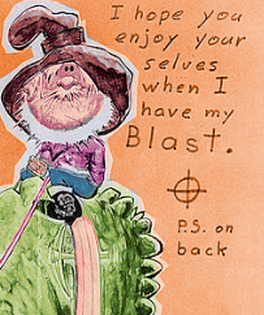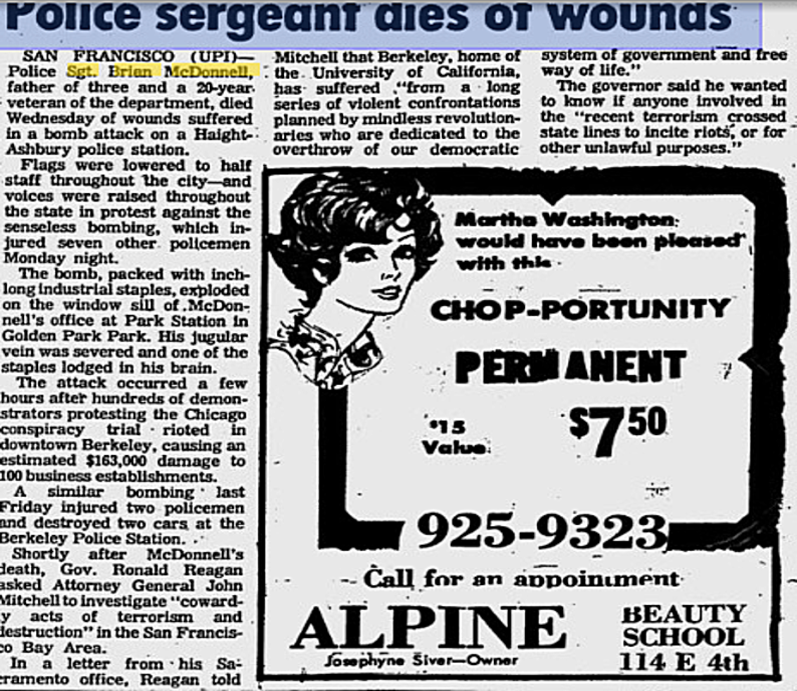
On April 20th 1970, the Zodiac Killer made reference to the murder of San Francisco police officer Brian McDonnell (44) on February 16th 1970, who suffered devastating and sadly fatal injuries two months earlier, when a bomb packed with fence staples exploded on an outside ledge of Park Police Station in the Upper-Haight neighborhood. He wrote "I hope you do not think that I was the one who wiped out that blue meannie with a bomb at the cop station", while simultaneously giving us a diagram of a bomb to be placed just 274 feet from another "cop station", that of Ingleside. This sense of irony didn't seem lost on the Zodiac Killer. What the Zodiac Killer knew of Brian McDonnell, other than what he read in the intervening two months is unknown, but in the remainder of his short message he stated "But there is more glory in killing a cop than a cid because a cop can shoot back". Was this just an offhand comment, or was this statement relevant to the history of Sergeant Brian McDonnell?
The Desert Sun newspaper of February 17th 1970 read: Haight Ashbury Police Station Rocked By Bomb Six Officers Injured In Blast Showering Big U-Shaped Staples.
SAN FRANCISCO (UPI) - A powerful bomb packed with U-shaped staples rocked a Haight-Ashbury District police station Monday night injuring six policemen, one of them critically. New Police Chief A. Nelder said the fused explosive was placed on the rear window sill of the sergeant’s office at Park Station in Golden Gate Park. The thunderous blast, which jarred residents for blocks around, sprayed staples through the office like miniature machinegun bullets. Sgt. Brian McDonnell fell gravely wounded with multiple head injuries. Patrolmen Robert Fogerty, 43, and Frank Rath. 27, were hospitalized with multiple puncture wounds. Officers Alfred Arnaud, 24, Robert O’Sullivan, 26. and Ronald Martin, 28, were treated for lesser injuries. “All I remember was a bomb exploded,” said one shaken officer who survived with only scratches. “I saw Sergeant McDonnell lying in the rubble, bleeding from an artery wound in his neck.” Police immediately sealed off the area and rerouted traffic. First reports indicated the building had been demolished. The blast did knock out all power in the station and shattered every window. It also demolished the sergeant’s police station wagon which was parked behind the station near Kezar Stadium, where the San Francisco Forty Niners play National Football League opponents. There were reports that a man was seen running from the station, and police later said a white and pink van was sighted leaving the area. However, there were no immediate suspects. Four days ago, three cars were blown up and two reserve policemen were injured by two bombs which exploded in a parking lot adjacent to the Berkeley police station across the bay from San Francisco. The explosive used in the Berkeley bombing was a metal pipe filled with powder and set off by a lighted fuse. The type of bomb used in the bombing of the Park police station was not determined immediately. A special U.S. Army bomb squad was summoned to the scene from the Presidio nearby. After the bombing, all district police stations in San Francisco were ordered to secure all doors and exits and post a guard.
The Desert Sun newspaper of February 17th 1970 read: Haight Ashbury Police Station Rocked By Bomb Six Officers Injured In Blast Showering Big U-Shaped Staples.
SAN FRANCISCO (UPI) - A powerful bomb packed with U-shaped staples rocked a Haight-Ashbury District police station Monday night injuring six policemen, one of them critically. New Police Chief A. Nelder said the fused explosive was placed on the rear window sill of the sergeant’s office at Park Station in Golden Gate Park. The thunderous blast, which jarred residents for blocks around, sprayed staples through the office like miniature machinegun bullets. Sgt. Brian McDonnell fell gravely wounded with multiple head injuries. Patrolmen Robert Fogerty, 43, and Frank Rath. 27, were hospitalized with multiple puncture wounds. Officers Alfred Arnaud, 24, Robert O’Sullivan, 26. and Ronald Martin, 28, were treated for lesser injuries. “All I remember was a bomb exploded,” said one shaken officer who survived with only scratches. “I saw Sergeant McDonnell lying in the rubble, bleeding from an artery wound in his neck.” Police immediately sealed off the area and rerouted traffic. First reports indicated the building had been demolished. The blast did knock out all power in the station and shattered every window. It also demolished the sergeant’s police station wagon which was parked behind the station near Kezar Stadium, where the San Francisco Forty Niners play National Football League opponents. There were reports that a man was seen running from the station, and police later said a white and pink van was sighted leaving the area. However, there were no immediate suspects. Four days ago, three cars were blown up and two reserve policemen were injured by two bombs which exploded in a parking lot adjacent to the Berkeley police station across the bay from San Francisco. The explosive used in the Berkeley bombing was a metal pipe filled with powder and set off by a lighted fuse. The type of bomb used in the bombing of the Park police station was not determined immediately. A special U.S. Army bomb squad was summoned to the scene from the Presidio nearby. After the bombing, all district police stations in San Francisco were ordered to secure all doors and exits and post a guard.
The uncle of Brian McDonnell was Sergeant Joseph Lacey (40), murdered on December 30th 1956 while socializing with a friend in a tavern. The two were enjoying a drink when two armed men burst into the establishment with the intention of robbing it. Sergeant Lacey, despite being off-duty at the time, drew his gun and attempted to put a stop to the robbery, but was beaten to the draw and sadly killed. One of the robbers was apprehended shortly after the crime and plead guilty to first-degree murder. The actual shooter of Sergeant Lacey remained a free man for nearly three years, before being captured and found guilty of second-degree murder. Fourteen years after the murder of Joseph Lacey, the end of watch would unfortunately befall his nephew, Brian McDonnell. Whether this historical case was mentioned in the newspapers to some degree in relation to the Brian McDonnell murder is unknown - but if it was featured and noted by the Zodiac Killer, the sentence of "there is more glory in killing a cop than a cid because a cop can shoot back" would certainly have more meaning with respect to the April 20th 1970 communication.
 Click image to view the outside of the card
Click image to view the outside of the card Would it be surprising the Zodiac Killer after reading and referencing the attack on Park Police Station, that he would then focus his bomb threats in close proximity to another police station on April 20th 1970 and June 26th 1970. The diagram of the bomb location on April 20th 1970, coupled with the radians and inches values from July 26th 1970, leaves little doubt that the unfortunate murder of Brian McDonnell was the catalyst for his remaining bomb threats towards Ingleside Police Station in 1970. It is also unsurprising that after reading headlines such as "Six Officers Injured in Blast Showering Big U-Shaped Staples", that the Zodiac Killer would follow up his April 20th communication with the Dragon card on April 28th 1970, writing on the front of the card "I hope you enjoy yourselves when I have my Blast". He would repeat this approach on the card inner, stating "If you don't want me to have this blast you must do two things".
The Dragon card is thought to depict the Miguel de Cervantes Saavedra characters of Don Quixote and Sancho Panza. This may have been a deliberate choice on behalf of the Zodiac Killer, as these characters were featured in statue form within Golden Gate Park, the location of Park Police Station. The two locations are about one mile from one another. Despite claiming he wasn't responsible for the Park Station bombing, he certainly wasn't averse to mocking the police at a time of immense grief. The Zodiac Killer, despite making many threats to murder by use of bomb, constantly made excuses for not doing so. On November 9th 1969 he claimed that the bomb was ready for "future use". On April 20th 1970, the problem was "I have killed ten people to date. It would have been a lot more except that my bus bomb was a dud. I was swamped out by the rain we had a while back". On June 26th 1970 he promised to annihilate a full school bus, "but now school is out for the summer". It seemed for the Zodiac Killer the lingering threat was all that was required, pouring huge doubt on him having any serious intentions of following through on his bomb threats towards San Francisco. Knowing that the police had to take the threats seriously was satisfactory enough for a killer who thrived on instilling fear in the Bay Area community.
The Dragon card is thought to depict the Miguel de Cervantes Saavedra characters of Don Quixote and Sancho Panza. This may have been a deliberate choice on behalf of the Zodiac Killer, as these characters were featured in statue form within Golden Gate Park, the location of Park Police Station. The two locations are about one mile from one another. Despite claiming he wasn't responsible for the Park Station bombing, he certainly wasn't averse to mocking the police at a time of immense grief. The Zodiac Killer, despite making many threats to murder by use of bomb, constantly made excuses for not doing so. On November 9th 1969 he claimed that the bomb was ready for "future use". On April 20th 1970, the problem was "I have killed ten people to date. It would have been a lot more except that my bus bomb was a dud. I was swamped out by the rain we had a while back". On June 26th 1970 he promised to annihilate a full school bus, "but now school is out for the summer". It seemed for the Zodiac Killer the lingering threat was all that was required, pouring huge doubt on him having any serious intentions of following through on his bomb threats towards San Francisco. Knowing that the police had to take the threats seriously was satisfactory enough for a killer who thrived on instilling fear in the Bay Area community.

